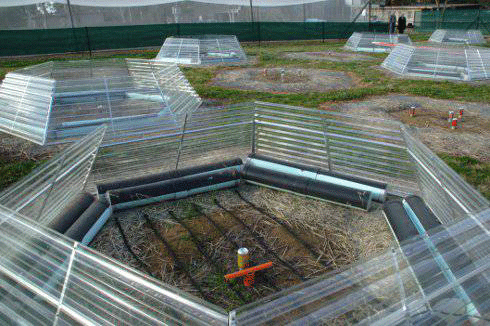
|
Published: 8 August 2011
Climate change: plants can protect but also need to adapt
Restoring native vegetation will help protect Australia’s unique ecosystems from the impacts of climate change, according to scientists from the Australian National University (ANU).

|
|
Dr Robert Godfree is using open-top chambers to understand how native and invasive plant communities will respond to climate change. Credit: CSIRO
|
A review published in the international, peer-reviewed journal Climatic Change, found that large-scale restoration of native vegetation was the most frequently recommended action in the scientific literature to counter climate change effects on biodiversity.
‘Reducing the area of native vegetation cleared is the most important action to take,’ says lead author, Dr Don Driscoll from the ANU’s Fenner School of Environment and Society. ‘But in areas that are already over-cleared, revegetation is essential.’
Dr Driscoll added that the review identified additional policies that would lead to faster reduction in the risks to biodiversity.
‘These are mainly actions that avoid further impacts, such as stopping the introduction of new invasive species and preventing further habitat loss,’ he says.
‘National efforts must include engagement in international negotiations on climate change conventions, trade and conservation conventions.’
Meanwhile, CSIRO scientists are investigating the potentially damaging effects climate change will have on Australia’s agricultural crops and native plants as carbon dioxide concentrations, temperatures and rainfall patterns change.
‘We’re facing an urgent need to develop new crop varieties for anticipated conditions in 20 to 50 years,’ says Dr Jairo Palta, a team leader in CSIRO’s climate-ready cereals project.
Dr Palta has studied the performance of different wheat traits under predicted future climate conditions. The results will enable wheat breeders to select traits that maximise growth and quality.
Another CSIRO researcher, Dr Robert Godfree, is investigating how native and invasive plant communities will respond to climate change.
‘Grasses are an important component of healthy agricultural ecosystems, yet there is relatively little data on how they will respond to climate change,’ says Dr Godfree.
Dr Joe Miller and his CSIRO colleagues are modelling the predicted distribution of Acacia (wattle) species around Australia, using climate variables such as temperature, available water and solar energy, soil type and topographic elevation.
‘Once we understand what climate variables are intrinsically tied to wattle habitats, we can predict where these habitats will move to in the future,’ says Dr Miller.



